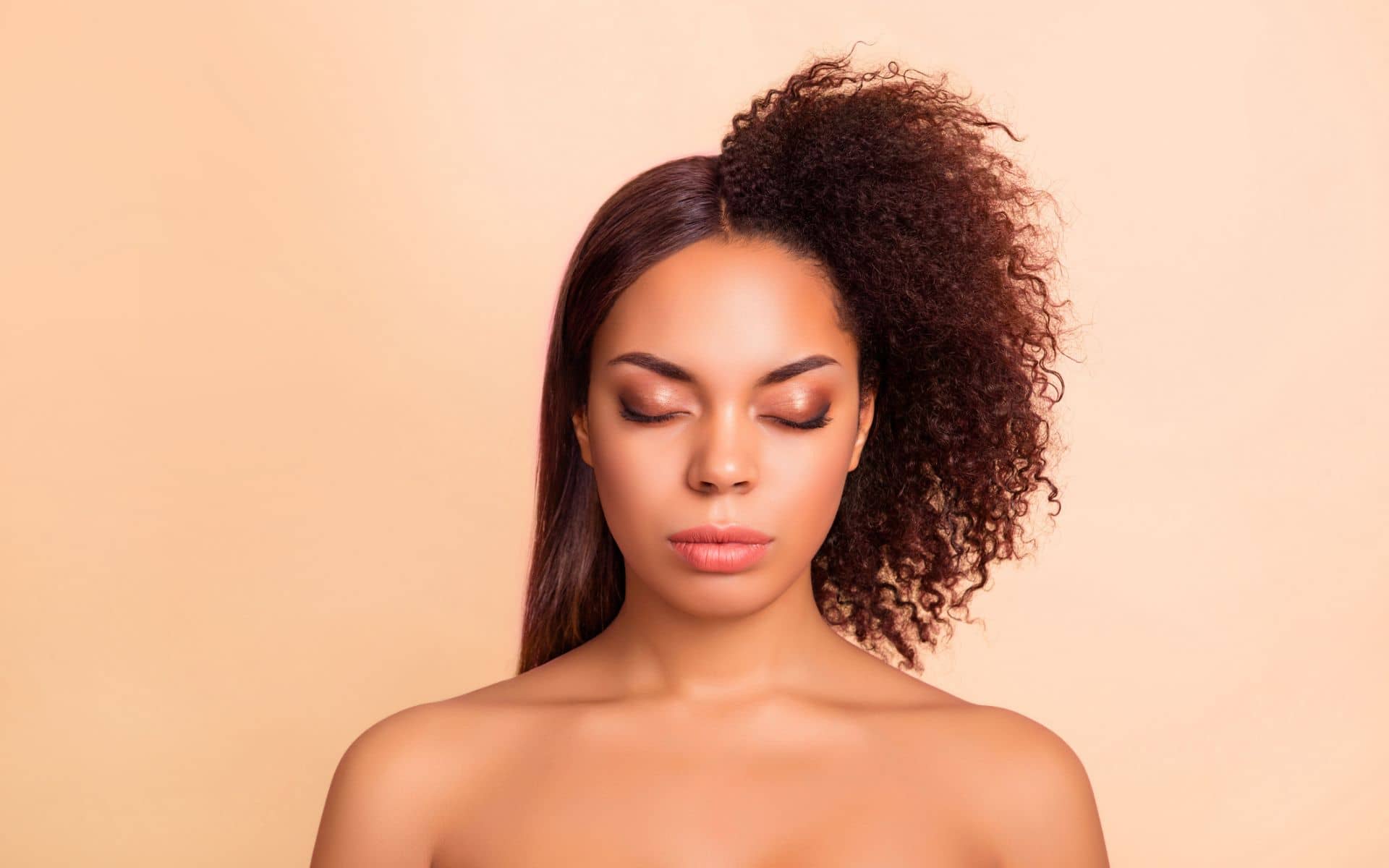This post may contain affiliate links and we may get paid a small commission if you click on a link. Please read our privacy policy and cookies disclosure.
When it comes to maintaining your natural hair, it’s important to identify what your hair needs to care for it in the right way. Identifying and understanding your hair porosity is equally as important as knowing your hair type. Regardless of if you’re Type 3 or 4 Naturalista – we all have different porosity types which will impact the products we choose to use and customise our natural hair routine to achieve our hair goals. Knowing your hair porosity (low, medium or high) and its characteristics will help you boost your natural hair regimen and ensure your hair is being treated with the right level of care.
Have you ever been in a situation where you’ve been trying viral hair products but not necessarily seeing the same results as everyone else? OR Does your hair feel like a product just sits on top of it as opposed to being absorbed through the hair strands? OR Do you find that regardless of what products you use your hair always seems dry? Well, you’re not alone! Every Naturalista has encountered this at some point during their hair care journey and these problems arise based on your hairs ability to absorb and hold onto moisture.
What is Low Porosity hair?
Porosity is an indicator of how easily moisture can penetrate through your hair shaft. It’s mainly determined by genetics but other factors such as the use of heat and chemicals have a part to play. If you have low porosity hair, it means your hair is lacking moisture in comparison to medium and high porosity hair types. This is due to low porosity having a harder time absorbing and retaining moisture.
Naturals with low porosity hair have tightly aligned hair cuticles which create a barrier for moisture to enter and penetrate through the strands. Their hair is also water resistant which can make it difficult to absorb moisture, water and hair products.
Here are 5 characteristics that will help you identify if you have low porosity hair;
- It takes longer for your hair to get completely wet when saturated with water
- Heat is required for moisture to penetrate through
- You have a high tendency for product build up
- Products tend to sit on top of the hair strands
- It takes longer to dry
How to Know if you have Low Porosity Hair?
It’s best to do a test to figure out your hair porosity. The process is pretty simple to follow and all you’ll need is a glass of water and a strand of hair. It’s best to do this test on freshly cleansed hair. Do not do this test on dirty hair as your results will not be accurate.
Simply take a clean, product-free strand of loose hair and put it in a glass of water. If the hair floats to the top then it’s low porosity, if it sinks slowly or settles in the middle it is medium/normal porosity, and if it sinks straight to the bottom then it is high porosity. See diagram below;


The results of the test will give you your answer. It’s also worth reviewing the characteristics we mentioned earlier to see if you relate. It’s likely you’ve been aware of the characteristics but didn’t know you had low porosity hair.
How to Care for Low Porosity? Plus Steps to Implement into your Natural Hair routine
Caring for low porosity natural hair can be frustrating at times. Especially because it repels water and natural hair requires hydration and moisture to thrive. In fact, it’s even more important to keep low porosity hair hydrated in comparison to other porosity types. But don’t panic…the good news is, there are several ways you can get moisture to penetrate through your hair strands. You’ll just have to work a little harder to get your hair fully hydrated by incorporating different methods/techniques.
We’ll give you a run down on the basics you’ll need to incorporate into your natural hair routine to ensure your low porosity hair is getting the moisture it needs. Note – even though you have the same porosity as other naturals, your hair might react differently so take your time to find the right routine and figure out what works best for you.
How often should you cleanse/wash low porosity hair?
Low porosity hair is prone to build up as products tend to sit on top of the hair rather than penetrate through the strands. As a result, you’ll need to clarify your hair regularly. The recommendation is typically every 1 – 2 weeks and ensure your hair is thoroughly clean by doing at least 2 rounds of shampooing. There will be weeks where you’ll have more buildup in between wash days depending on your styling options. So pay attention to signs of build up (i.e. residue, dry or itchy scalp, flakiness or dullness) once it appears and get rid of it.
How do you moisturise low porosity hair?
As low porosity struggles to take in moisture. You need to pay close attention to the ingredients in your products. Unfortunately, just piling on hair products won’t keep your hair moisturised. Instead, it’ll lead to product build up which is what you want to avoid. Use lightweight products without a lot of oils in order for the moisture to penetrate through the hair shaft. Products with film-forming humectants help your hair retain water and then follow through with a light oil to seal in the moisture.
How to grow low porosity hair?
Natural hair grows up to 6 inches per year, in some cases it can be less or more. Hair growth is down to a variety of factors such genetics, lifestyle, hair manipulation from styling, supplements etc. The key to hair growth is having a healthy scalp so step 1 is clarify your hair. Make your cleansing your hair regularly to ensure your hair follicles aren’t clogged up by oils and excess product which will keep your scalp in a healthy state. Step 2 is to retain as much hair growth as possible. There are various ways to retain length such as protective styling, keeping your hair hydrated and getting regular trims. Utilising these techniques will help moisture get into the hair strands and will reduce the risk of dry and brittle hair which leads to breakage.
To grow low porosity hair, you’ll need to customise your hair routine to fit your hair care needs. The focus should be clarifying, moisturising, using the right products that contain humectants and minimise the use of heavy oils. Note; other factors will have a part to play such as eating habits, lifestyle etc but if you can focus on finding the right routine then you should be fine. One way to stay on top of your progress is by tracking and documenting your natural hair journey so you know where to make changes and improvements.

9 Low Porosity Haircare Tips to incorporate into your Natural Hair Routine
Now you understand what hair porosity is and how cleansing and getting hydration into the strands can help you maintain healthy hair. Here are some things you’ll want to incorporate into your natural hair routine to boost your regimen and ensure your low porosity hair is properly cared for. You don’t have to do them all but suggest trying a couple and figure out what works best for you.
1. Use products with the right ingredients
It’s important to use ingredients that will penetrate through your hair shafts as opposed to drying it out further. You should always check the ingredients in all your products especially shampoos, conditioners and moisturisers. Stay away from anything that contains sulphates and silicones. Instead, use hair products that contain film-forming humectants that help retain water in your hair. These humectants have moisturising ingredients that create a clear, flexible film over your strands to help resist dehydration.
Examples of film-forming humectants:
- Marshmallow root
- Flaxseed gel
- Aloe vera
- Slippery Elm
- Pathenol
- Hydroxyproplytrimonium honey
- nettle leaf tea or nettle extract
2. Use the correct oils to seal in moisture
Using oils is an effective way to seal moisture into your cuticles. However, there are certain oils that won’t work for low porosity hair. For example, coconut oil is raved about in the natural hair community but due to the oil being quite heavy – it doesn’t actually add much benefit to low porosity naturals and just sits on top of the hair strands. The best oils for low porosity hair are lightweight oils. They are known for penetrating through your roots and hair shafts increasing the chances of your hair absorbing it. You might also want to stay away from heavy butters and try an avocado, mango or murumuru butter which is light in texture and has sealing properties.
Examples of lightweight oils: Jojoba oil, Avocado oil, Grapesed oil, Sweet almond oil, Argan oil and Sunflower oil.
TIP – Always use oils as the last step! You want to apply it after you moisturise your hair and use it to seal the moisture into your hair strands. If you apply oil onto your strands prior to moisturising then you’ll be locking out moisture as opposed to getting it into the hair shaft.

3. Always use heat when deep conditioning
Heat is a great way to open up your hair’s cuticle and works extremely well for low porosity hair. For your hair to reap the full benefits of your deep conditioner – you need to open up the cuticles. The cuticles will naturally open when you clarify your hair with warm water but it’s important not to wait for your hair to dry before applying your deep conditioner. Apply it straight away so you to get the benefits of the moisturising ingredients. It’s best to leave the treatment on your hair for at least 30 mins and apply a shower cap to keep the product from drying out. Sit under a hooded dryer or heat cap to keep your cuticles open.
You should aim to use a deep conditioning treatment at least twice a month. It might sound like a laborious process but trust me it’s worth it! You’ll start to see improvements in your hair’s health and it’s ability to retain moisture. Learn more about the benefits of deep conditioning here.
4. Utilise steam
Steam is another method of opening up your hair cuticles and offers similar benefits to using heat and warm water. The difference with steam is it works slightly quicker. This is because the water molecules are in vapour form which move quicker than liquid molecules to penetrate your hair. There are hand hair steamers you can purchase and use in between washes to open up your hair cuticles when moisturising your hair. Alternatively, you can use the steam from a hot shower if you don’t want to invest in a steamer. Remember, steam alone can’t hydrate your hair so use it as a step prior to moisturising your hair.
5. Always apply products to damp hair
This is a pretty simple step, you don’t need to completely saturate your hair. But you can use a spray bottle to spritz your hair prior to applying your products to help the ingredients penetrate through your hair strands. Water is every Naturalista’s friend! Although low porosity hair has a harder time absorbing it – it doesn’t mean you should eliminate it completely. TIP – use warm water to open up your hair cuticles.

6. Try a pre-poo treatment
Pre-pooing is a way of prepping your hair prior to cleansing. There are a variety of ways you can pre-poo your hair using products such as masks, oils, scrubs and deep conditioning treatments. Shampoo is known for stripping your hair of its natural oils and moisture. Pre-pooing is a way of retaining that moisture. This is extremely useful for low porosity hair as it minimises and prevents the stripping of your hair from the shampoo.
7. Don’t skip trims
Trims are vital for any hair type but key for low porosity hair it’s essential due to your hair being drier and brittle in texture.. This leads to split ends travelling up the hair shaft quickly eventually leading to breakage. Ideally, you want to trim your hair every 8 weeks but if you prefer to stretch your trim you can opt for every 12 weeks. The key is to maintain healthy hair and have a consistent routine.
8. Sleep with a silk pillowcase
Have you ever gone to bed with your scarf or bonnet and found it on the floor or somewhere on your bed when you wake up? I’m sure we’ve all had this experience at some point which is why sleeping with a silk pillowcase provides you with that extra protection. Cotton pillowcases are known for drying out hair whilst silk pillowcases help keep moisture in your coils/curls for longer. You can opt for satin pillowcases too, they tend to be significantly cheaper than silk but it won’t retain moisture as well as silk. Aside from the benefits for your hair, you’ll notice a difference on your face. So throw that cotton pillowcase away and upgrade to a smoother silkier option that has better benefits for you.

9. Treat and prevent build up
Build up is something low porosity naturals battle with a lot. Unfortunately, the hair strands find it difficult to absorb moisture which leads to products sitting on top of your strands. One way you can curb build up in low porosity hair is by using a clarifying shampoo – incorporate it into your natural hair routine and start of with once a month to stay on top of it. If you’re interested in a natural hair remedy then opt for a apple cider vinegar rinse. All you need to do is dilute 1 spoon of vinegar with a cup of water and spritz on your hair after shampooing. Make sure you get the whole length of your hair and scalp. Then follow up with a conditioner or deep conditioning treatment to get that moisture back into your hair strands.
FAQ’s re: Low Porosity Natural Hair Routine
1: How do you treat low porosity hair?
We’ve covered the majority of the elements of how to treat low porosity hair above but a quick takeaway is to stay away from heavy products which will lead to build up. Stick to lightweight products that have the right moisturising benefits. You can always utilise treatments such as pre-poos and deep conditioners to get that extra moisture and hydration into your hair strands. Try to use heat and/or steam when using these treatments to open up the hair cuticle to ensure the ingredients get right through to the core of the strands.
2: What ingredients should I avoid for low porosity hair?
There are 2 main ingredients that are a no-go for low porosity hair! Silicones and Sulphates. Silicone makes your hair appear shiny after use which is why many people use it but it doesn’t actually keep your hair moisturised. Constant use of silicones can weaken the hair causing damage. Sulphates strip the hair of natural moisture which is a big no no for women with low porosity hair. The overuse of sulphates for low porosity naturals leads to excessive dryness and frizz. There are loads of sulphate free shampoos on the market so you’ll be able to find something that works for you.
3: Which oil is best for low porosity hair?
You want to opt for lightweight oils as opposed to heavy ones to minimise build up and clogging up your scalp. Luckily, there are many options on the market. Here are some of our favourite oils for low porosity hair;
- Jojoba Oil
- Sweet Almond Oil
- Grapeseed Oil
- Baobab Oil
- Argan Oil
- Pomegranate Oil
- Avocado Oil
4: Does low porosity hair need protein?
In general, natural hair needs the right balance of protein and moisture to thrive. The difference with low porosity hair is it doesnt need as much protein compared to other porosity types. The benefit of protein is it adds strength to your hair, it helps with elasticity and keeps your hair strong. But too much protein can leave your hair dry and brittle. As a low porosity natural, you may need to monitor how your hair reacts to protein treatments to decide how often you incorporate it into your routine. If you’re experiencing significant breakage or notice a drop in elasticity then it might be time to get a protein treatment.
Final Thoughts
We hope you got everything you need to boost your low porosity natural hair routine. Despite the challenges low porosity naturals face of retaining and absorbing moisture. There are a variety of ways you can get moisture into your hair strands. One of the things you’ll have to change straight away is reading the ingredients on products before purchasing them. Hair brands are very good at marketing products for hair growth and moisture but when you read the labels you’ll find harmful ingredients that don’t add any benefit. Get into the habit of doing your research so it doesn’t have any detrimental impact on your hair’s health.
Do you have low porosity hair? What tips have you tried or recommend for other Naturalistas?











Mimi
Thanks for the tips. What about olive oil and blackseed oil for low porosity hair or are they considered too heavy?
NaturalistaVibes
Blackseed oil is considered as a lightweight oil. Unfortunately, olive oil is classed as heavy. But one way you can get around the heaviness is by mixing it with other lightweight oils which will dilute it slightly. Some low porosity naturals use olive oil as part of their pre-pooing treatment so thats another way you can incorporate it if you really want to use it. I hope that helps and thanks for highlighting blackseed oil.